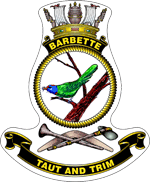HMAS Barbette (P 97)
HMAS Barbette (P 97) was an Attack class patrol boat of the Royal Australian Navy (RAN).
| History | |
|---|---|
| Builder: | Walkers Limited |
| Launched: | 10 April 1968 |
| Commissioned: | 16 August 1968 |
| Decommissioned: | 15 June 1984 |
| Motto: | "Taut and Trim" |
| Fate: | Sold to Indonesian Navy |
| Badge: |
 |
| Name: | Siada |
| Acquired: | 22 February 1985 |
| Status: | Active as of 2011 |
| General characteristics | |
| Class and type: | Attack class patrol boat |
| Displacement: |
|
| Length: | 107.6 ft (32.8 m) length overall |
| Beam: | 20 ft (6.1 m) |
| Draught: |
|
| Propulsion: |
|
| Speed: | 24 knots (44 km/h; 28 mph) |
| Range: | 1,200 nautical miles (2,200 km; 1,400 mi) at 13 knots (24 km/h; 15 mph) |
| Complement: | 3 officers, 16 sailors |
| Armament: |
|
Design and construction
The Attack class was ordered in 1964 to operate in Australian waters as patrol boats (based on lessons learned through using the Ton class minesweepers on patrols of Borneo during the Indonesia-Malaysia Confrontation, and to replace a variety of old patrol, search-and-rescue, and general-purpose craft.[1] Initially, nine were ordered for the RAN, with another five for Papua New Guinea's Australian-run coastal security force, although another six ships were ordered to bring the class to twenty vessels.[1] The patrol boats had a displacement of 100 tons at standard load and 146 tons at full load, were 107.6 feet (32.8 m) in length overall, had a beam of 20 feet (6.1 m), and draughts of 6.4 feet (2.0 m) at standard load, and 7.3 feet (2.2 m) at full load.[1][2] Propulsion machinery consisted of two 16-cylinder Paxman YJCM diesel engines, which supplied 3,460 shaft horsepower (2,580 kW) to the two propellers.[1][2] The vessels could achieve a top speed of 24 knots (44 km/h; 28 mph), and had a range of 1,200 nautical miles (2,200 km; 1,400 mi) at 13 knots (24 km/h; 15 mph).[1][2] The ship's company consisted of three officers and sixteen sailors.[2] Main armament was a bow-mounted Bofors 40 mm gun, supplemented by two .50 calibre (12.7 mm) M2 Browning machine guns and various small arms.[1][2] The ships were designed with as many commercial components as possible: the Attacks were to operate in remote regions of Australia and New Guinea, and a town's hardware store would be more accessible than home base in a mechanical emergency.[3]
Barbette was built by Walkers Limited at Maryborough, Queensland,[4] launched on 10 April 1968, and commissioned on 16 August 1968.[4]
Operational history
Barbette paid off on 15 June 1984. She was transferred to the Indonesian Navy on 22 February 1985 and renamed KRI Siada (862).[5] The patrol boat was listed in Jane's Fighting Ships as still operational in 2011.[5]
Citations
- Gillett, Australian and New Zealand Ships since 1946, p. 86
- Blackman (ed.), Jane's Fighting Ships, 1968–69, p. 18
- The patrol boat, Australian National Maritime Museum
- Gillett, Australian and New Zealand Ships since 1946, p. 87
- Saunders, Stephen, ed. (2011). Jane's Fighting Ships 2011–2012. Coulsdon: IHS Jane's. p. . ISBN 9780710629593. OCLC 751789024.
References
- Blackman, Raymond, ed. (1968). Jane's Fighting Ships, 1968–69 (71st ed.). London: Jane's Publishing Company. OCLC 123786869.
- Gillett, Ross (1988). Australian and New Zealand Warships since 1946. Brookvale, NSW: Child & Associates. ISBN 0-86777-219-0. OCLC 23470364.
- "The patrol boat". Australian National Maritime Museum. Archived from the original on 6 July 2011. Retrieved 30 June 2011.